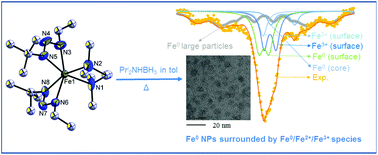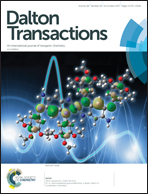Asymmetrically substituted triazenes as poor electron donor ligands in the precursor chemistry of iron(ii) for iron-based metallic and intermetallic nanocrystals†
Abstract
Triazene ligands are introduced, for the first time, in the precursor chemistry for their ability to afford oxygen-free molecular precursors of Fe0 nanoparticles. For this purpose, we synthesized new asymmetric triazene ligands t-BuN![[double bond, length as m-dash]](https://www.rsc.org/images/entities/char_e001.gif) N-NHR (R = Et, i-Pr, n-Bu) featuring different alkyl substituents at 1,3-N centers, as well as a symmetric ligand t-BuN
N-NHR (R = Et, i-Pr, n-Bu) featuring different alkyl substituents at 1,3-N centers, as well as a symmetric ligand t-BuN![[double bond, length as m-dash]](https://www.rsc.org/images/entities/char_e001.gif) N-NHt-Bu and used them to develop novel heteroleptic monomeric FeII triazenide derivatives [Fe(t-BuN3R)2(TMEDA)] (where TMEDA = tetramethylethylenediamine). A range of physico-chemical studies such as FT-IR, TG-DTA, 1H & 13C NMR, mass spectrometry, single crystal X-ray structure analysis, cyclic voltammetry and Mössbauer spectroscopy were used to characterize these newly synthesized ligands and FeII derivatives. One representative derivative [Fe(t-BuN3Et)2(TMEDA)] was evaluated as a precursor for the synthesis of metallic Fe0 and intermetallic Al13Fe4 nanoparticles by the chemical solution deposition method.
N-NHt-Bu and used them to develop novel heteroleptic monomeric FeII triazenide derivatives [Fe(t-BuN3R)2(TMEDA)] (where TMEDA = tetramethylethylenediamine). A range of physico-chemical studies such as FT-IR, TG-DTA, 1H & 13C NMR, mass spectrometry, single crystal X-ray structure analysis, cyclic voltammetry and Mössbauer spectroscopy were used to characterize these newly synthesized ligands and FeII derivatives. One representative derivative [Fe(t-BuN3Et)2(TMEDA)] was evaluated as a precursor for the synthesis of metallic Fe0 and intermetallic Al13Fe4 nanoparticles by the chemical solution deposition method.



 Please wait while we load your content...
Please wait while we load your content...